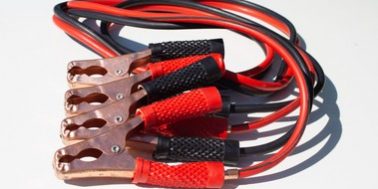If your car’s battery has gone flat, you may be able to restart it using a jump start, but it is important that you are educated on the correct way to complete this action. Jump leads have the capability to cause damage to vehicles and people if they are used incorrectly and so if you aren’t confident in the use of one, it is important that you call for the help of a trained professional. If you are eager to carry out this battery restart yourself, then pay close attention to our eight simple steps.
Remember – this is a basic guide aimed towards no specific vehicle. If the instructions in your car’s handbook alter in any way from ours, follow your own vehicles step-by-step.
Your jump-starting checklist
To complete a jump start, you will need to be prepared with the following:
- A pair of working jump leads
- The vehicle with a flat battery, located in a spot where the jump leads can reach the battery easily and without strain
- A vehicle with a fully charged battery (excluding electric or hybrid vehicles)
Our safety tips
It is important to remember that batteries produce highly flammable gasses and it is important that you remain safe throughout the jump starting process with these top tips:
- Observe the battery. You must never attempt to jump start a battery that is leaking or damaged
- Observe the jump leads. You must never attempt a jump start with damaged leads.
- Remove any loose jewellery or clothing accessories, such as scarves and ties, that could get caught in the engine.
- Remove all jewellery and metallic accessories, such as necklaces, rings and hair grips, as these could cause dangerous sparks which could lead to a battery explosion if contact is made.
- Stop using the jump leads if they begin to get hot.
- Do not remove jump leads whilst the vehicles engines are running as this could cause extreme damage to the electrics within the vehicle.
8 simple steps
- Park both cars so that their bonnets are facing each other, allowing them to be close in proximity but not touching and switch both ignitions off.
- Connect the red jump lead to the positive (+) terminal of the working battery and the positive (+) terminal of the flat battery.
- Connect one half of the black jump lead to the negative (-) terminal of the working battery and the other to an earthing point that is situated a distance away from the flat battery. This will be an unpainted part of metal upon the engine block.
- Keep both engines switched off for just under 5 minutes before starting the ignition of the working car and letting it run for 60 seconds.
- If the jump leads remain cool after this minute has passed, start the engine in the vehicle with the flat battery.
- Leave both engines running for around 10 minutes.
- Turn both ignitions off and carefully remove the jump leads in the opposite order to how you first fitted them. (Remove the black lead from your earthing point first, and then the negative (-) terminal of the secondary vehicle before removing the red lead from the flat battery and then the working batteries positive (+) terminals.) Do not allow the leads to touch each other or the vehicles.
- Once the leads have been removed, start the engine to see if the flat battery has been recharged successfully.
If you find that our steps didn’t resolve the issue with your vehicle’s battery, do not repeat. Instead, call for professional roadside assistance or for a member of our Double Dee Autos team for expert advice.
For battery advice and assistance, or any other vehicle needs from MOTs to air conditioning services, give us a call on 020 8460 3040 or drop us an email at ben@ddautos.co.uk and we will be happy to help.

